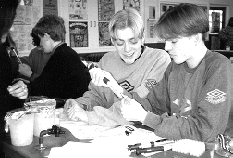

Anne Millner, head of science at Sir John Lemen School, Beccles, said to me ‘Do you think it would be possible to come in to school and talk to my students about genetic engineering?’. Within a month Anne had rearranged the school timetable and I was planning for a complete one-day practical on genetic engineering for the sixth form biology students. Maureen Bibb and Rekha Chakeraburtty from the John Innes Centre came along with me.
Our aim was to create a ‘library’ of Escherichia coli chromosomal DNA fragments, using recombinant DNA techniques with laboratory strains of E. coli grown the previous night.
After introducing ourselves, I followed with a bit on safety, and then spoke about what we were going to do: i.e. to create new bacteria by using genetic engineering, and have some fun doing it. Then we got stuck in.
First the students learned to handle micropipettors, and then the students worked from a very simple set of figures that I had drawn annotating them as they went along.
Loading an Agarose gel requires concentration and precision, yet the results from this stage showed that every group had successfully prepared their own plasmid DNA and, in the majority of cases, that it had been cut. At the end of the day, the agar plates were carefully labelled and then incubated. Two days later the ‘recombinant’ bacteria had grown and the experiment was complete. The students had learned about the processes involved and were going on to investigate more about genetic engineering.
We three had a great day and, judging from the comments and the thank you letters sent afterwards, I know the students had as well. One of my favourite bits was when Neil Sanderson, the head of the school biology department, came into the class at the end of the day and said that he had just stopped a student in the corridor and asked her what a ‘restriction endonuclease’ was; she told him.